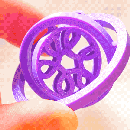Introduction: Hacking USB + Power Banks
Have you ever had a servo go crazy on you in the middle of a project? Or had LEDs change colors when they weren't supposed to? Or even wanted to power a toy but were tired of disposing of batteries? I have run into numerous situations where having a long lasting, easily chargeable, safe, consistent battery would be helpful. I have found a solution in cutting up USB cables.
Watch video for more details:
What you need:
- USB Cable
- Toy/Arduino/Micro:bit
- Power Bank
- Solid Core Wire
Necessary Equipment:
- Soldering Iron
- Solder
- Wire cutters
- Wire Stripper
Optional:
- Solder Flux
- Heat Shrink
- Heat gun
- Electrical Tape
Safety Warning:
Using damaged, cut, or altered USB cables in any way can cause fires, burns, and damage the equipment connected at either end. Despite this, these cables can be safely used in the right context. I use them frequently with students to power projects, and most things they come in contact with are built with enough rigor to prevent any permanent damage. For example, most laptop/computer USB ports will temporarily shut down if shorted out, and will come back after the computer has been restarted.
Step 1: Hacking USB Cables (Part 1)
The best cables to use are usb cables just used for charging, that have no data connection, but most will do. Expensive cables like lightning cables have a lot of extra stuff going on, and don't work well for this.
Here are the steps:
- Cut the end off the USB cable, and strip back the outer insulation.
- If it is a data cable, cut the extra wires (not the black and red ones)
- Strip the insulation off the remaining two wires.
- Strip the insulation off the solid core wire
Step 2: Hacking USB Cables (Part 2)
Next, we solder the ends of the USB cable to the solid core wire.
Here are the steps:
- Wrap the wire from either the positive or negative lead from the USB cable around the solid wire
- Spread solder flux over the wrapped wires (this is optional, but helps the solder flow more easily, allowing for a quicker, cleaner connection)
- Solder wires together.
- Clip solid wire to length with wire cutters
- Repeat with the other wire
Step 3: Adding Heat Shrink
It is helpful to add either colored heat shrink, or electrical tape to both provide strain relief to the wires, and to help indicate which wire is positive/negative.
If the wires are not colored in a way that indicates they are obviously positive or negative, you can use a multimeter to measure the polarity, and determine the positive end. When positive is connected to positive, the multimeter should read positive, and if positive is connected to negative, it should read negative.
If the wires are tiny, you can bundle them together with additional tape or heat shrink to prevent them from getting ripped out.
Step 4: WARNING!!!
A reminder that you can start fires or damage electronics by using these. Power banks come with numerous protections, including short circuit protection where they will shut themselves off when shorted out. If these protections fail, it will generate large amounts of heat, and potentially start a fire.
Another concern, is that power banks can provide large amounts of current, and when connected to wires not made to handle that current, they can heat up and become a fire risk. You can see in the image that when 2.5A is run through a breadboard that is only meant for 500mA (.5A), it generates a large amount of heat.
Be safe, and make sure to use wires and connectors designed for large amounts of current when using large amounts of current.
Step 5: Hooking Up Hacked Cables to Toys
You can power toys with a USB cable. This can be done with toys that use 3-4 AAA all the way to D batteries, because they run on 4.5-6V, which is what the usb connection provides. If you attempt to power a 3v or lower toy with the power bank, it will likely damage the toy. If you try to use it to power toys that require a higher voltage, it might work, but might not. If you connect it to the toy backwards, you also risk damaging the toy.
All that is needed is to connect the positive wire to the positive side (+) and the negative wire to the negative side (-), and plug it in.
Step 6: Arduino Current Limitations
Before we discuss using this to help out with Arduino circuits, it may be helpful to understand why Arduino projects (and other microcontroller projects) might benefit from this. The Arduino Uno can provide about 500mA through the usb connection on the board. As you add additional LEDs/motors/servos, more current is required, but the connection isn't able to provide more. This causes things to behave unpredictably, causing servos to dance, and LEDs to start changing to the wrong color. You can see in the image, as more LEDs are added, the current only increases slightly, and this causes the LEDs to change from white to yellow to red.
Step 7: Arduino Connection
To add additional USB power to the arduino, take your newly hacked cable, and connect the positive side to the 5v rail on the breadboard (or bypass the breadboard and connect it straight to the LED), and the negative side to the negative rail on the breadboard. At this point, you can see that suddenly much more current is provided to the LEDs, and they do not change color. When powered this way, you can even disconnect the Arduino from the standard USB connection, because it will be powered via the 5v pin.
If wired backwards, the Arduino will short out and shut itself off. Potentially it can irreversibly damage the Ardiuno (although I have yet to encounter this)
Step 8: Micro:bit Current Limitations
Like Arduino, micro:bit can only supply so much current. In this case, it provides about 180mA, causing LEDs to again change color.
Step 9: Wiring LEDs Connected to the Micro:bit
Powering the LEDs with USB while controlled by Micro:bit is much trickier; there are two key things to be careful of. First, do not allow the 5v red pin to connect to the Micro:bit pins. All the Micro:bit pins are rated at 3.3v (they can probably handle a bit more), and while It may be able to survive it, it is a risk not worth taking. The second consideration, is that because the 5v wire is isolated from the Micro:bit, the ground (negative) wire must connect to both the negative end of the LED strip, and the ground pin on the Micro:bit. This is because the voltage difference is needed for the signal from the Micro:bit to the LEDs to work.
So, carefully move the positive connection on the LEDs from the 3.3v pin of the Micro:bit to the USB cable, and do the same with the ground connection. Then, take an additional wire, and connect it to the ground pin of the Micro:bit, and to the negative wire from the USB cable. Now you are good to go.
You can see from the images that there is plenty of current for the Micro:bit now.
Step 10: Finished
If you attempt this, be smart, and be careful. Power banks are handy for powering projects and last for a very long time. They are more convenient to charge than other battery options, and USB connections are plentiful.
Thank you for reading. If you are interested in seeing future projects, please subscribe to my Youtube channel: More Than The Sum

Participated in the
Electronics Tips & Tricks Challenge













